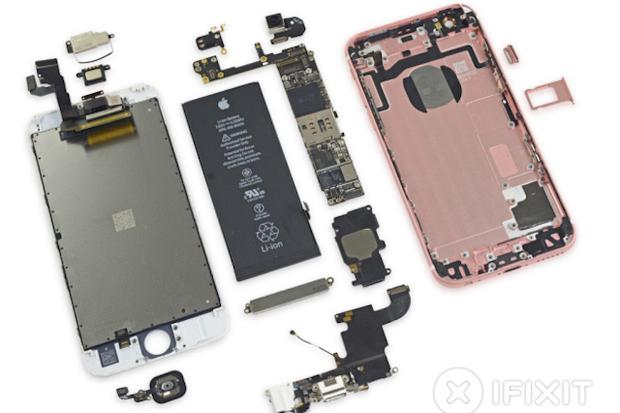
iFixit's teardown of the iPhone 6S reveals the industry's latest DRAM memory with twice the capacity and speed as the previous version. Credit: iFixit
The iPhone 6S comes with twice the DRAM memory of its predecessor and the very latest in memory technology, which boosts performance by as much as 100%.
Rumors that the iPhone 6S, which began shipping last week, would double down on its DRAM capacity had been around for the past several months, but iFixit's teardown confirmed them this past week.
One surprise: Not only does the iPhone 6S come with 2GB of DRAM, but it uses Samsung's leading-edge LPDDR4 memory. SK Hynix is producing the memory for the iPhone 6S Plus.
LPDDR4, which stands for "low power, double data rate random access memory," boasts a top performance speed of 3,200Mbps compared to the 1,600Mbps performance of LPDDR3, which was used in the iPhone 6.
 Samsung
Samsung Samsung's LPDDR4 memory chips.
Samsung introduced LPDDR4 in its Galaxy S6 smartphone earlier this year.
Mike Howard, a DRAM and memory analyst with IHS, said LPDDR4 is a significant upgrade compared to LPDDR3. Not only is it twice as fast, but also it consumes less power and promises higher memory densities than LPDDR3.
"It is worth pointing out that the LPDDR3 has only been around for a few years. Volume shipments of LPDDR3 really only started in 2013, so it's being replaced rather quickly by LPDDR4," Howard stated in an email response to Computerworld.
Howard also drew a comparison between LPDDR4 and DDR4 (DDR4 being the next generation of common computing DRAM and the successor to DDR3). The primary benefit LPDDR4 offers over DDR4 is power; LPDDR4 consumes far less -- 1.2 volts versus 1.1 volts.
"Those benefits do come at a cost in so much that if all things are held equal, LPDDR4 will cost slightly more to manufacture than DDR4," Howard said.
The LPDDR3 used in the iPhone 6 also was a single-channel die, while LPDD4 uses two channels with 16 bits per channel, for a total of 32 bits. Shorter and faster data paths improve the new chip's overall energy use.
IHS predicts LPDDR4 will be the predominant mobile DRAM technology next year. At present it's expected to be found predominantly in high-end devices, but it will begin the transition to more mid-tier devices next year.
Currently, there is no successor to LPDDR4 on the horizon, according to IHS, which believes the new DRAM standard will be able to satisfy the memory demands of mobile devices for quite some time and for much longer than LPDDR3 was viable.
Join the CIO Australia group on LinkedIn. The group is open to CIOs, IT Directors, COOs, CTOs and senior IT managers.
